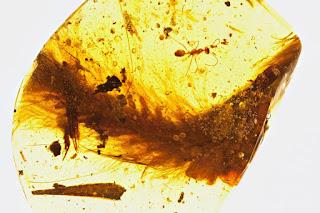These are my personal five picks for the top science stories of 2016. Three of them are space-related, which is only fitting with my space-themed debut novel coming out next year. Feel free to chime in down in the comment section with your own top picks, if they aren't on this list.
Anyhow, without further ado, here we go!
5. Proxima b
 |
| Image by ESO/M. Kornmesser |
This past August, the European Southern Observatory reported the discovery of an Earth-like planet orbiting the star nearest to our own. Finding new exoplanets isn't as surprising as it used to be, but it's still super exciting to find one this close to our own place in space!
This planet orbits Proxima Centauri, a star only 4 light-years away. It is in the habitable zone, meaning it could have liquid water on its surface and temperatures within the range of our own here on Earth. It is 1.3 times the size of our planet, and probably rocky. To get there with modern technology would still take us 70,000 years, but folks are already planning ways to do it faster!
4. A Sappy Dino Tail
 |
| Credit: R.C. McKellar, Royal Saskatchewan Museum |
This wouldn't be a Top 5 list from me without something prehistoric on it. It was hard choosing which paleontology story I was most excited about in 2016, but in the end, I had to go with the dinosaur tail stuck in freaking amber.
This amazing find came from Myanmar, and dates back to 99 million years ago. CT scans of the tail inform its classification as a dinosaur, but the type of feathers suggest it likely was not capable of flight. Also lodged in the amber with the tail was an ant, who unlike the dinosaur, didn't get away.
3. We Have
In a moment I'll never forget, on April 8th, SpaceX successfully landed its reusable Falcon 9 rocket booster on a drone barge in the middle of the Atlantic after launching it from Florida. This is a stunning example of engineering at its finest.
I'm so excited about this, you guys. The destruction of rockets during launch has been an expensive barrier for many missions. If the boosters can be reused, this opens the doors to an easier, more economical future for space travel! What an accomplishment.
(Oh, and also, it just looks really cool to see a rocket land on a flat boat in the middle of the ocean.)
2. Gravitational Waves are Real
 |
| Aerial shot of LIGO |
In what is topping the list for many other sites, I have decided that this discovery will be my 2nd choice for Top Story of the Year. But it is really freaking awesome, so don't think I don't love it.
Decades ago, Einstein predicted this discovery. The concept is that when two massive objects accelerate around one another, such as during the merger of two black holes, it will cause gravitational ripples in the universe, like a stone dropped in a pond. These ripples will actually expand and compress spacetime itself. But how to test it?
Well, LIGO (the Laser Interferometer Gravitational-Wave Observatory) had the answer. Have two lasers in equal-lengthed tunnels aimed at a 90 degree angle from one another. Measure them carefully. And wait.
This year, LIGO observed that one tunnel's laser measured a different distance than the other's for a moment in time. One laser registered as shortening, while the other as lengthening. This compression and extension indicated that spacetime was distorted during the measurements. (And this has been replicated!) Gravitational waves have passed through! They're real, and Einstein was right...again!
This has been a discovery 50 years in the making. So why isn't it my #1? Well, let's get to it and find out.
1. The Antarctic Ozone Hole is Healing
 |
| Image credit: NASA |
My top science story for 2016 is one of hope, in a time when we really, really need it.
The Antarctic Ozone Hole, which forms every year in the spring when a chemical reaction occurs in the atmosphere, is finally getting smaller. This comes nearly 30 years after an international treaty was signed to reduce the use of ozone-destroying compounds in industry.
As a kid, this was the biggest environmental crisis of the time. Years before I learned about global warming, my worries were focused on the hole in our ozone. It seemed impossible to fix it. All we could try to do, from my childhood understanding, was not make it any worse. Even that, however, sounded farfetched.
But we are fixing it. We're doing it! Intense public outreach about this issue, and some serious worldwide cooperation, is to thank for this environmental disaster being reversed. I had to make this my number one story, because it is proof that we can work together to change how we do things and save our planet from catastrophe.
Let's push forward, and fight for similar changes on other environmental fronts in 2017 and beyond. This should be a lesson to all of us, and a beacon of hope. We're succeeding with one major fight. We can succeed with others!
Let's do this, 2017!





